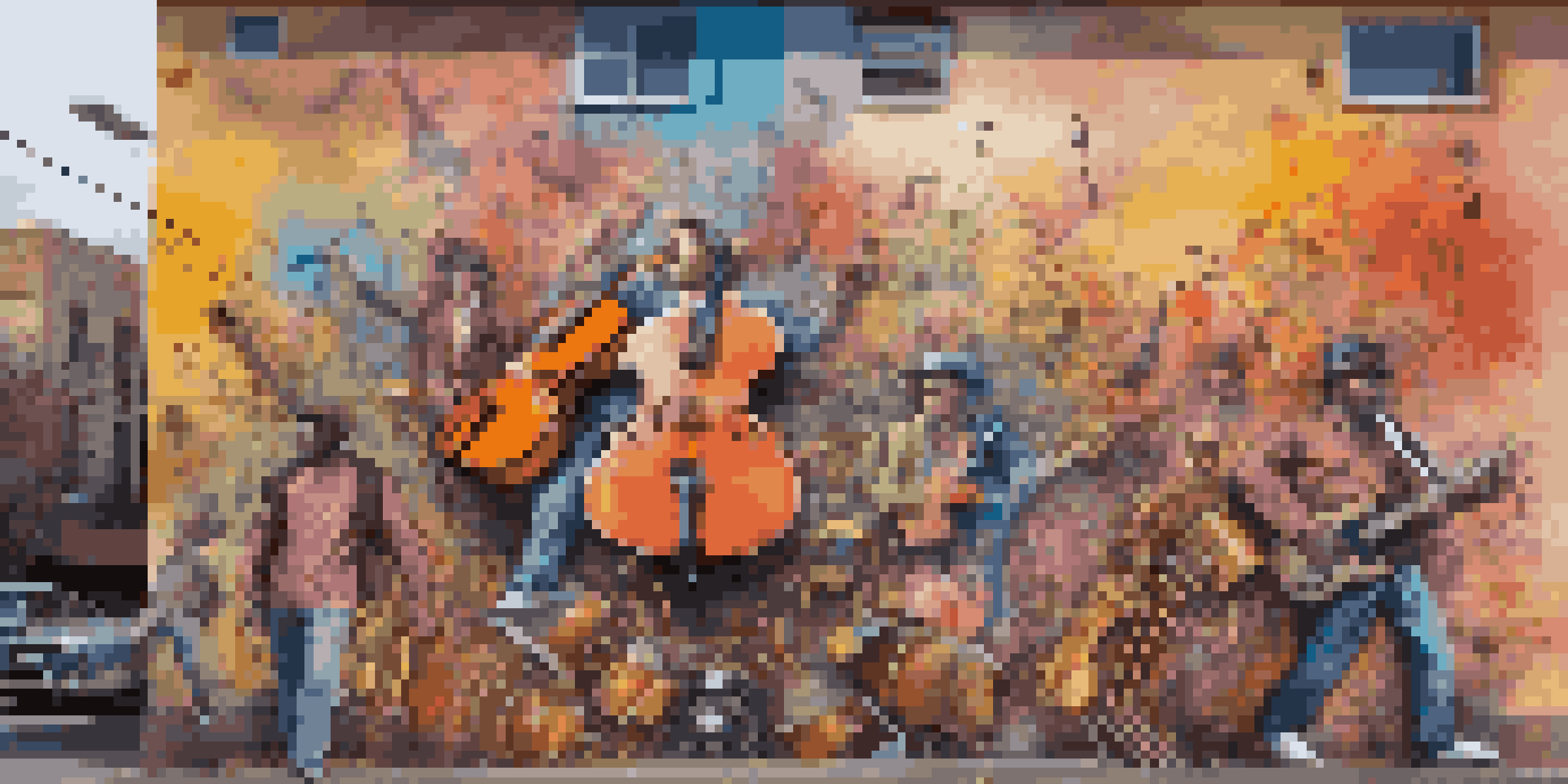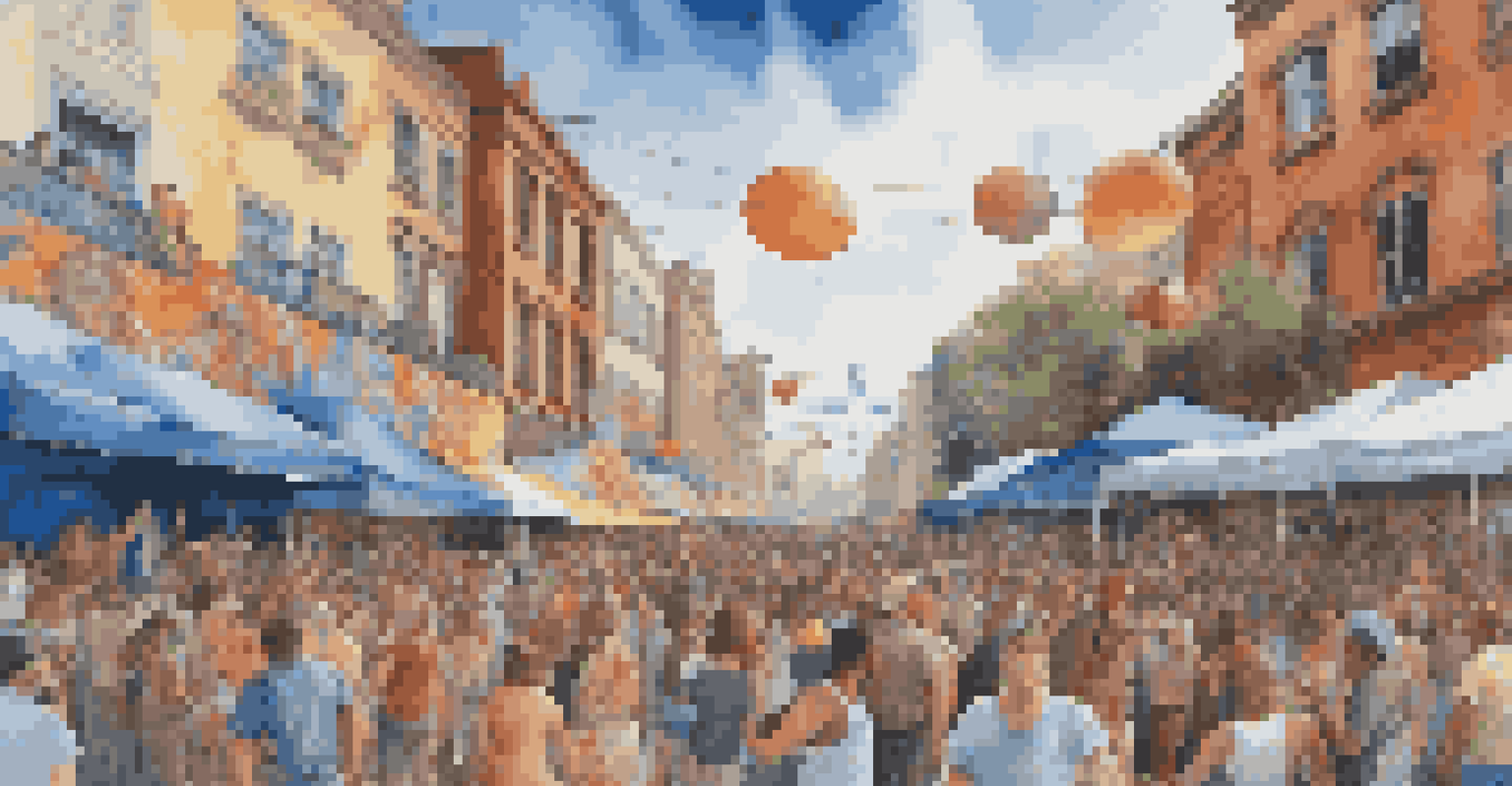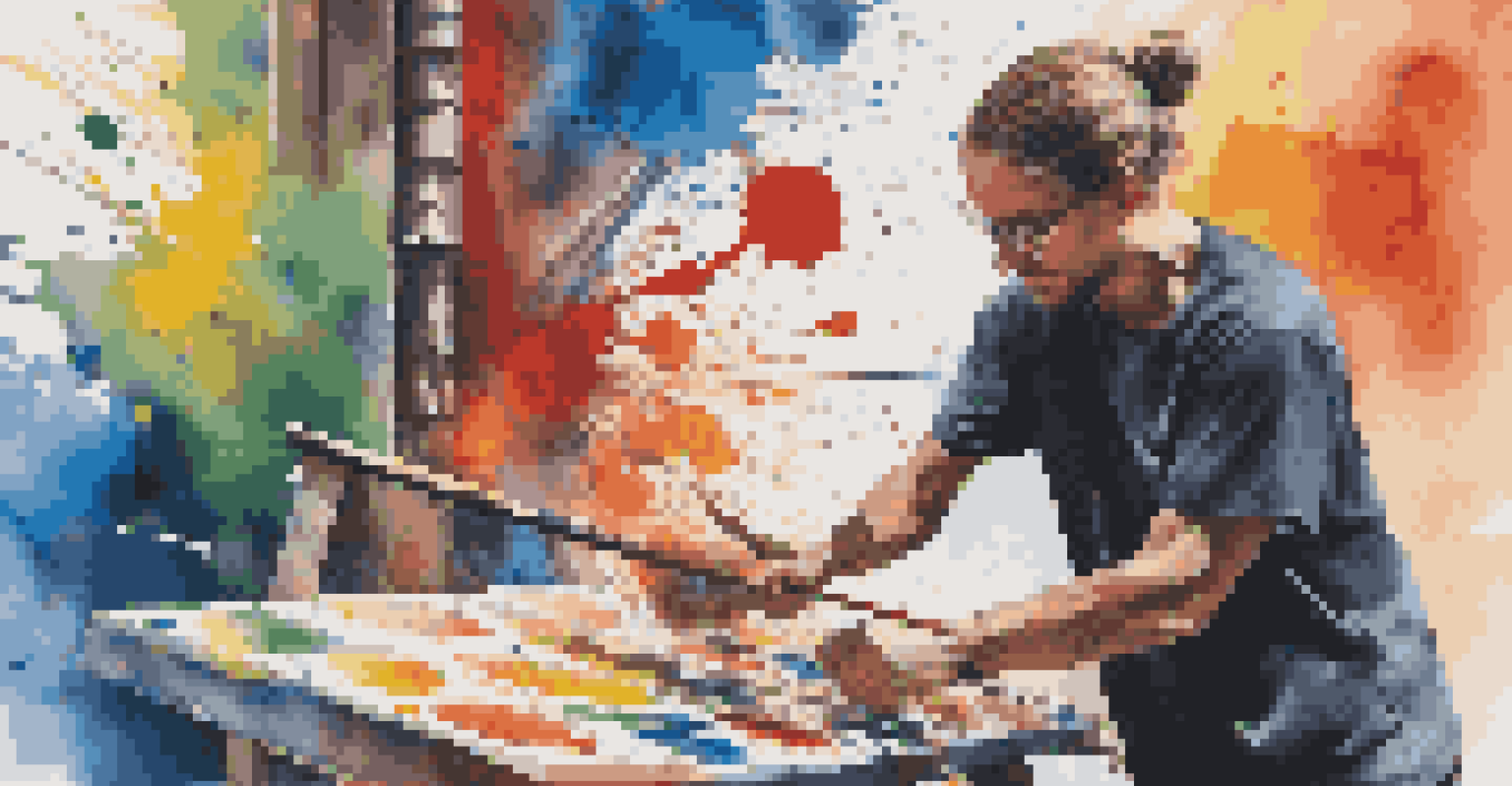Street Art and Music: An Interdisciplinary Exploration

The Intersection of Street Art and Music: A Cultural Fusion
Street art and music often coexist in urban spaces, creating a vibrant tapestry of culture. Both forms of expression reflect the voices and stories of communities, transforming public spaces into galleries and stages. When artists merge these two disciplines, they create a powerful synergy that captivates audiences and fosters dialogue.
Art is not freedom from discipline but disciplined freedom.
For instance, murals often depict scenes from local music history, while musicians might draw inspiration from the visual art surrounding them. This interplay not only enriches the artistic experience but also invites passersby to engage with both mediums. As a result, cities become living, breathing canvases that celebrate their unique cultural identities.
Ultimately, the relationship between street art and music highlights the importance of creativity in urban environments. It encourages collaboration among artists, musicians, and communities, sparking innovation and social change. This fusion is more than just aesthetic; it's a reflection of the dynamic spirit of modern urban life.
The Role of Street Art in Music Promotion
Street art has become an essential tool for promoting music, especially for local artists. Murals and graffiti often serve as eye-catching advertisements for upcoming shows, albums, or festivals. This grassroots approach not only reaches a diverse audience physically but also resonates emotionally with the community.

Take, for example, the vibrant murals that celebrate iconic musicians or bands in various neighborhoods. These artworks not only honor the artists but also create a sense of pride among local residents. When people see their favorite musicians celebrated in their own streets, it fosters a connection that encourages attendance at live events.
Art and Music: A Cultural Synergy
Street art and music combine to create a vibrant cultural tapestry that reflects community stories and fosters dialogue.
Moreover, social media amplifies this effect, as street art becomes shareable content, allowing music promotion to reach an even wider audience. The visuals often draw people in, leading to increased engagement with the music itself. In this way, street art acts as a bridge between the artist and the audience, enhancing the overall music experience.
Musical Inspiration Behind Street Art Creations
Many street artists find inspiration in music, using it as a driving force behind their creative processes. The rhythms, lyrics, and emotions expressed in songs often translate into their visual work. This connection can be seen in the themes and messages conveyed through their murals, echoing the sentiments found in their favorite tracks.
Music is the shorthand of emotion.
For instance, an artist might listen to a powerful anthem while painting, allowing the song's energy to influence their brush strokes and color choices. This synergy creates art that not only represents the artist's vision but also resonates with the music's audience. It’s a beautiful reminder of how interconnected these creative expressions can be.
Additionally, collaborations between musicians and street artists often lead to unique projects that blend both worlds. These partnerships create a multi-sensory experience for audiences, inviting them to explore the narrative behind the art in a new light. It's an example of how music and street art can elevate each other, resulting in a richer cultural dialogue.
Street Art Festivals: Celebrating Music and Visual Art
Street art festivals often serve as a vibrant celebration of both music and visual art, drawing crowds from far and wide. These events feature live performances alongside stunning murals being created in real-time, allowing attendees to experience creativity in action. It's a unique environment where artists and musicians collaborate, share ideas, and inspire one another.
During these festivals, the atmosphere is electric, with the sounds of live music blending seamlessly with the visual spectacle of street art. People can wander through the streets, discovering new artists and sounds while enjoying the transforming landscape around them. This immersive experience fosters a sense of community and belonging among participants.
Street Art as Music Promotion
Murals and graffiti serve as eye-catching advertisements for local music events, enhancing community engagement.
Furthermore, these festivals often highlight local talent, providing a platform for emerging artists and musicians to showcase their work. This focus on local culture helps to strengthen community ties and promote the unique identity of the area. As a result, street art festivals become a powerful vehicle for cultural expression and celebration.
Social Issues in Street Art and Music: A Creative Response
Both street art and music have long been used as vehicles for social commentary, addressing pressing issues within society. Artists often tackle themes such as inequality, violence, and environmental concerns through their work, sparking conversations and raising awareness. This intersection of art and activism allows for powerful narratives to emerge.
For example, a mural depicting social justice movements can be complemented by a song that echoes similar sentiments, creating a cohesive message. This dual approach not only amplifies the impact of the message but also encourages audiences to engage with the issues on multiple levels. It turns art into a catalyst for change, fostering empathy and understanding.
Moreover, the accessibility of street art and music makes them effective tools for reaching diverse audiences. Unlike traditional forms of art that may be confined to galleries, street art can be found in everyday spaces, while music can be shared easily online. This democratization of art allows for a broader range of voices to be heard, creating an inclusive platform for dialogue and action.
Technological Innovations Shaping Street Art and Music
Technology has significantly influenced both street art and music, opening up new avenues for creativity and collaboration. Digital platforms allow artists to share their work instantly, while musicians can easily distribute their music to a global audience. This accessibility not only broadens their reach but also fosters innovative collaborations between the two disciplines.
For instance, augmented reality (AR) has introduced exciting possibilities for street art, where viewers can interact with murals through their smartphones, experiencing layers of sound and visual storytelling. This blend of technology and creativity enhances the audience's experience, making art more immersive and engaging. It’s a testament to how traditional forms of expression can evolve in the digital age.
Technology Enhances Artistic Expression
Digital innovations, like augmented reality, are transforming how street art and music connect, creating immersive experiences for audiences.
Additionally, social media has become a vital tool for both street artists and musicians, enabling them to connect with fans and showcase their work. Hashtags and online challenges can lead to viral trends, where street art inspires new music, and vice versa. This symbiotic relationship highlights the ever-evolving landscape of creativity in our modern world.
Future Trends: The Evolution of Street Art and Music
As we look to the future, the relationship between street art and music is likely to grow even more intertwined. Emerging trends suggest that collaboration will become the norm, with artists from both fields working together to create multi-faceted experiences. This evolution will continue to challenge traditional boundaries and redefine what art can be.
Moreover, as societal issues become more complex, we can expect street art and music to respond with innovative narratives that reflect our current realities. Artists will likely leverage technology and social media to amplify their messages, reaching wider audiences and inspiring action. This adaptability will ensure that both forms of art remain relevant and impactful.

In essence, the future of street art and music is bright, filled with potential for creativity and collaboration. By embracing new ideas and technologies, artists will continue to push the envelope, inspiring future generations to express themselves boldly. This ongoing relationship will undoubtedly shape the cultural landscape for years to come.